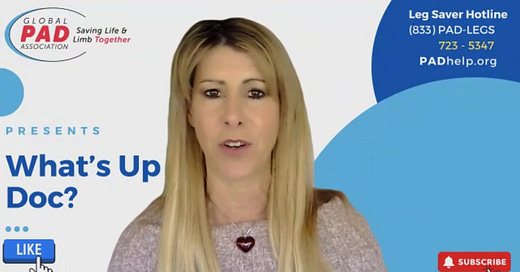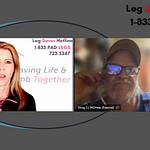In this week’s edition of our popular “What’s Up Doc” series, Global PAD Association CEO
sits down with Dr. Thomas Hodgkiss, an interventional radiologist from Southern VIP, which serves patients across Tennessee, Kentucky, and Mississippi. Their conversation revealed important insights about comprehensive PAD care and innovative pain management approaches that patients should know about.The “Total Care” Philosophy for PAD Patients
Dr. Hodgkiss began by emphasizing his commitment to what he calls “total care” for PAD patients. Unlike clinics that simply “treat the blockage and send them back,” his approach involves addressing both vascular issues and pain management from day one.
“When that patient joins us, there’s the vascular side of our patient clinics and then there’s the pain side,” Dr. Hodgkiss explained. For patients presenting with leg pain, his team conducts a thorough risk assessment that includes arterial ultrasound and toe-brachial index (TBI) measurements when indicated.
This comprehensive approach ensures that critical vascular issues aren’t overlooked. “You’ve got to restore blood flow to see how much relief you can get by doing that before you head down the pain treatments,” he emphasized.
Looking Beyond “Diabetic Neuropathy”
One of the most striking discussions centered on misdiagnosed “diabetic neuropathy.” Dr. Hodgkiss noted that many patients arrive with this diagnosis but have never had their vascular system properly evaluated.
“It’s amazing how everybody [says] ‘I’ve got diabetic neuropathy, there’s nothing I can do about it,’” Dr. Hodgkiss observed. “And then the next question is, ‘Has anybody looked at your blood flow?’”
Kym McNicholas highlighted the alarming statistics from the Global PAD Association’s leg saver hotline: 35% of patients who called were told their amputations were due to diabetes alone, yet 100% of these patients were found to have undiagnosed PAD when properly evaluated.
The Critical Importance of Foot Artery Treatment
Dr. Hodgkiss expressed concern that with so many diabetic patients not getting diagnosed soonest, they end up presenting in advanced stages once a wound appears that won’t heal. Many of these patients at that point, he explains, have rock hard calcium filling the smallest arteries clear into the pedal/plantar loop in the foot. And yet, many doctors still won’t open those small arteries up, saying it can’t be done or shouldn’t be done. In this interview, he passionately advocated for treating the “loop” - the pedal plantar loop in the foot that many interventionalists neglect, especially on diabetic patients with wounds that won’t heal.
“They’ll go and fix the iliac arteries in the abdomen, they’ll fix the SFA, the superficial femoral artery in the thigh… but then they don’t get any further,” McNicholas noted.
Dr. Hodgkiss explained that treating these foot arteries often brings dramatic relief: “You go and you open up those arteries and you see how much relief they get. I’m astonished.” Most remarkably, this critical treatment often lacks proper reimbursement, requiring physicians to go “the extra mile” for their patients.
Advanced Pain Management: Spinal Cord Stimulation
For patients who still experience pain after restoration of blood flow, Dr. Hodgkiss discussed spinal cord stimulation as an effective option. These implantable devices work by blocking pain signals as they travel back to the brain.
“When we revascularize down there, I’m seeing patients… they’ll come back and first thing you do is show me how they can wiggle their toes. And the sensation, their balance is better,” he explained.
The procedure involves placing electrodes in the epidural space, typically around the T7 vertebra level for leg pain. Patients first undergo a trial period to ensure effectiveness before permanent implantation. Modern devices offer numerous advantages:
Non-rechargeable batteries last 3-4 years, while rechargeable systems can last up to 10 years
Software updates can be delivered wirelessly to improve performance
Different stimulation patterns can be customized for each patient
Most patients report about 50% pain reduction long-term, which significantly improves quality of life
The procedure can be performed under conscious sedation
DRG Stimulation: Targeted Relief for Specific Pain
During the Q&A, patient Marcia asked about Dorsal Root Ganglion (DRG) stimulation, which Dr. Hodgkiss described as highly effective for specific pain patterns. Rather than treating the entire spinal cord, DRG targets specific nerves where they enter the spinal cord.
“What makes these approaches so exciting is their potential for more focused relief,” Dr. Hodgkiss explained. “Instead of blocking the whole spinal cord up near T7, this is more specific, which makes it work better and can almost completely shut down the pain there.”
This approach is particularly beneficial for patients with complex regional pain syndrome (CRPS) or pain localized to specific areas of the foot or leg.
Walking Therapy: Simple but Effective
In this week’s conversation, the power of walking as therapy was highlighted by both Dr. Hodgkiss and audience member Kathy, who shared her experience with a walking program in the UK.
Walking IS THE BEST TREATMENT FOR PAD. It’s also considered FRONTLINE treatment and a regimented walking program such as that offered by the Global PAD Association, should be followed for three months prior to any intervention for patients in early to moderate stages of PAD, to see if the body stimulates collateral vessel growth, which create natural bypasses around artery blockages.
“Walking helped,” Kathy explained, noting how it gradually improved her claudication symptoms. Her experience was part of a research trial that combined walking with TENS (Transcutaneous Electrical Nerve Stimulation) therapy applied to the calves.
The TENS unit provided just enough distraction from claudication pain to allow patients to walk further and build endurance. Interestingly, Kathy found that eventually, she could walk the same distances without the TENS unit, suggesting that the walking itself created lasting improvements.
Practical Tips for Managing Claudication Pain
When asked about varying claudication symptoms and quick remedies, Dr. Hodgkiss offered practical advice about mineral supplementation:
“I think the minerals… the first thing I go to,” he noted. “Get [patients] kids chewable magnesium and calcium, and those can help relax those muscles. Really works.”
The discussion also touched on the importance of proper hydration for optimal blood flow. Dr. Hodgkiss suggested that mineral-rich water might provide additional benefits beyond plain “empty water.”
Cutting-Edge Treatments on the Horizon
Throughout the conversation it’s important to note that Dr. Hodgkiss mentioned several innovative technologies that show promise for PAD patients, including:
New 1.7mm laser technology that’s “so powerful” for treating arterial blockages and stent restenosis
Lithotripsy (sound wave) therapy that can “crack” calcium buildup in vessels, which is especially helpful in the larger arteries in the abdomen and thigh (iliac and SFA)
The PTAB/Detour system for minimally invasive bypass procedure
Reflow Medicals’ Spur technology, retractable stent (investigational device)
These advances represent the continuing evolution of PAD treatment beyond traditional approaches.
Join us weekly at youtube.com/@thewaytomyheart for another episode of “What’s Up Doc” where we’ll continue answering your questions about peripheral artery disease. Remember, early diagnosis and appropriate management can significantly improve outcomes for PAD patients. If you have questions about PAD, call the Global PAD Association’s Leg Saver Hotline at 1-833-PAD-LEGS or go to PADhelp.org
To watch the full video of Kym’s discussion with Dr. Thomas Hodgkiss from Southern VIP, click the link at the top of the article.













Share this post